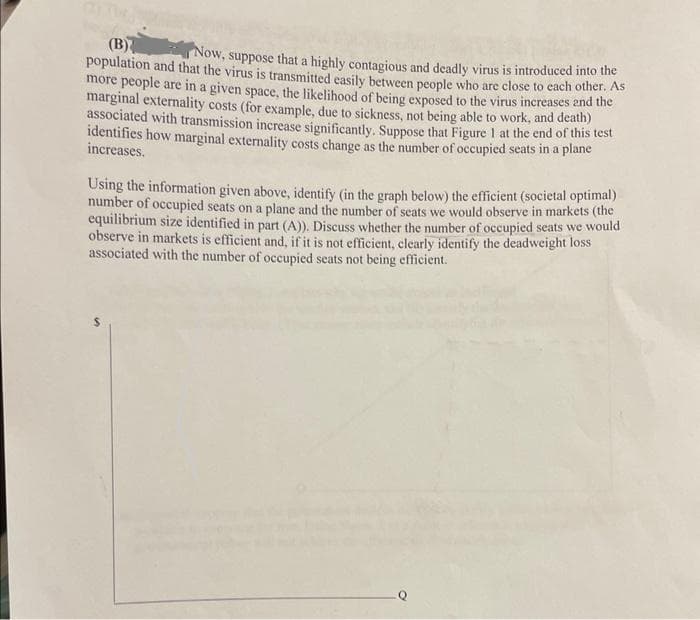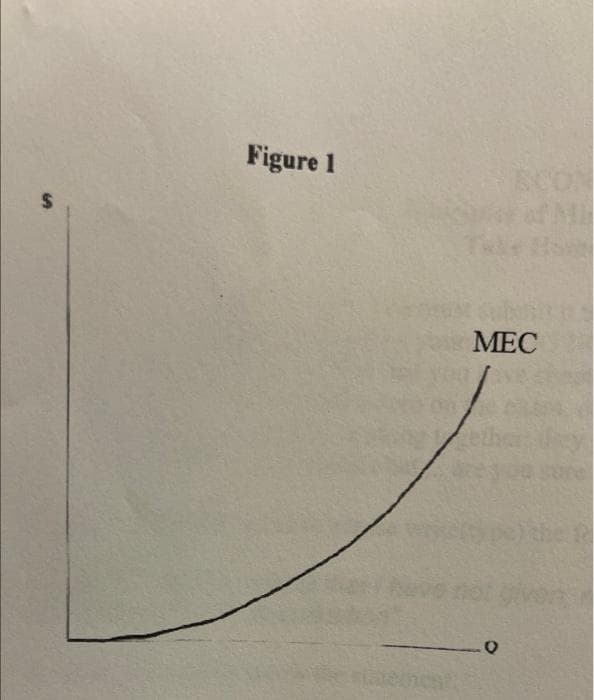(B) population and that the virus is transmitted easily between people who are close to each other. As Now, suppose that a highly contagious and deadly virus is introduced into the more people are in a given space, the likelihood of being exposed to the virus increases and the marginal externality costs (for example, due to sickness, not being able to work, and death) associated with transmission increase significantly. Suppose that Figure 1 at the end of this test identifies how marginal externality costs change as the number of occupied seats in a plane increases. Using the information given above, identify (in the graph below) the efficient (societal optimal) number of occupied seats on a plane and the number of seats we would observe in markets (the equilibrium size identified in part (A)). Discuss whether the number of occupied seats we would observe in markets is efficient and, if it is not efficient, clearly identify the deadweight loss associated with the number of occupied seats not being efficient.
(B) population and that the virus is transmitted easily between people who are close to each other. As Now, suppose that a highly contagious and deadly virus is introduced into the more people are in a given space, the likelihood of being exposed to the virus increases and the marginal externality costs (for example, due to sickness, not being able to work, and death) associated with transmission increase significantly. Suppose that Figure 1 at the end of this test identifies how marginal externality costs change as the number of occupied seats in a plane increases. Using the information given above, identify (in the graph below) the efficient (societal optimal) number of occupied seats on a plane and the number of seats we would observe in markets (the equilibrium size identified in part (A)). Discuss whether the number of occupied seats we would observe in markets is efficient and, if it is not efficient, clearly identify the deadweight loss associated with the number of occupied seats not being efficient.
Chapter7: Uncertainty
Section: Chapter Questions
Problem 7.8P
Related questions
Question
4

Transcribed Image Text:(B)
population and that the virus is transmitted easily between people who are close to each other. As
Now, suppose that a highly contagious and deadly virus is introduced into the
more people are in a given space, the likelihood of being exposed to the virus increases and the
marginal externality costs (for example, due to sickness, not being able to work, and death)
associated with transmission increase significantly. Suppose that Figure 1 at the end of this test
identifies how marginal externality costs change as the number of occupied seats in a plane
increases.
Using the information given above, identify (in the graph below) the efficient (societal optimal)
number of occupied seats on a plane and the number of seats we would observe in markets (the
equilibrium size identified in part (A)). Discuss whether the number of occupied seats we would
observe in markets is efficient and, if it is not efficient, clearly identify the deadweight loss
associated with the number of occupied seats not being efficient.

Transcribed Image Text:Figure 1
MEC
.O
Expert Solution
This question has been solved!
Explore an expertly crafted, step-by-step solution for a thorough understanding of key concepts.
Step by step
Solved in 2 steps with 1 images

Knowledge Booster
Learn more about
Need a deep-dive on the concept behind this application? Look no further. Learn more about this topic, economics and related others by exploring similar questions and additional content below.Recommended textbooks for you

